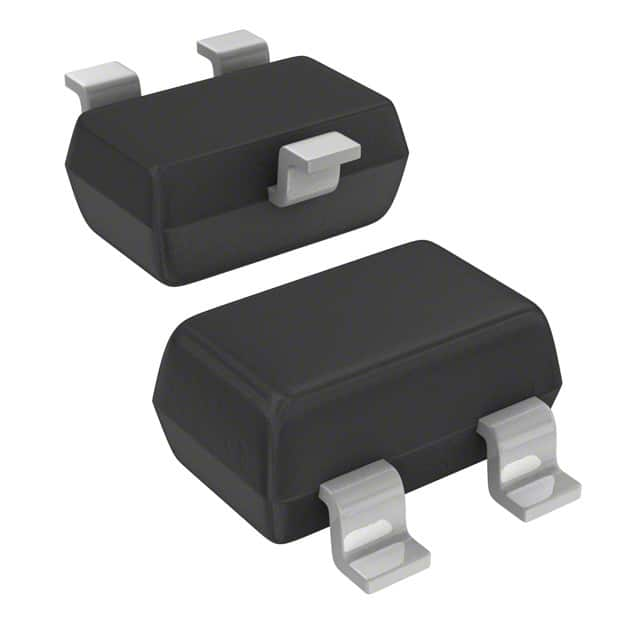Xem thông số kỹ thuật để biết chi tiết sản phẩm.

BSS123W Transistor: Encyclopedia Entry
Introduction
The BSS123W transistor is a crucial component in electronic devices, belonging to the category of field-effect transistors (FETs). This entry provides an overview of the BSS123W transistor, including its basic information, specifications, pin configuration, functional features, advantages and disadvantages, working principles, application field plans, and alternative models.
Basic Information Overview
- Category: Field-Effect Transistor (FET)
- Use: The BSS123W transistor is commonly used for switching and amplification applications in electronic circuits.
- Characteristics: It exhibits low on-resistance, high transconductance, and low input capacitance, making it suitable for low-power applications.
- Package: The BSS123W transistor is typically available in a SOT-23 package.
- Essence: It serves as a key component in electronic circuits, enabling signal amplification and switching functions.
- Packaging/Quantity: It is often supplied in reels or tubes containing multiple units.
Specifications
- Voltage Rating: Typically rated for 100V drain-source voltage.
- Current Rating: Commonly rated for 170mA continuous drain current.
- On-Resistance: Typically features an on-resistance of around 5 ohms.
- Capacitance: Exhibits low input and output capacitance, suitable for high-frequency applications.
Detailed Pin Configuration
The BSS123W transistor has three pins: 1. Gate (G): Controls the conductivity between the source and drain terminals. 2. Source (S): The terminal through which current enters the transistor. 3. Drain (D): The terminal through which current exits the transistor.
Functional Features
- Low On-Resistance: Enables efficient power management and reduced heat dissipation.
- High Transconductance: Facilitates high gain in amplification applications.
- Fast Switching Speed: Suitable for high-frequency switching applications.
Advantages and Disadvantages
Advantages
- Low on-resistance for efficient power handling.
- High transconductance for effective signal amplification.
- Compact SOT-23 package for space-constrained designs.
Disadvantages
- Limited maximum current and voltage ratings compared to larger transistors.
- Sensitivity to electrostatic discharge (ESD) due to smaller package size.
Working Principles
The BSS123W transistor operates based on the field-effect principle, where the voltage applied to the gate terminal controls the flow of current between the source and drain terminals. When a sufficient gate-source voltage is applied, the transistor enters the "on" state, allowing current to flow from the source to the drain.
Detailed Application Field Plans
The BSS123W transistor finds extensive use in various electronic applications, including: - Switching Circuits: Used to control the flow of current in digital and analog switching circuits. - Amplification Circuits: Employed to amplify weak signals in audio and radio frequency (RF) circuits. - Voltage Regulation: Integrated into voltage regulator circuits for efficient power management.
Detailed and Complete Alternative Models
Several alternative models to the BSS123W transistor include: - 2N7002: Similar SOT-23 packaged FET with comparable characteristics. - BS170: Higher voltage-rated FET suitable for power switching applications. - IRLML2502: MOSFET with lower on-resistance for higher power applications.
In conclusion, the BSS123W transistor is a versatile component widely used in electronic circuits for its efficient switching and amplification capabilities. Its compact size and favorable characteristics make it a popular choice for low-power applications across various industries.
Word Count: 511
Liệt kê 10 câu hỏi và câu trả lời thường gặp liên quan đến ứng dụng BSS123W trong giải pháp kỹ thuật
What is the BSS123W transistor used for?
- The BSS123W transistor is commonly used for low-power switching applications in technical solutions.
What are the key features of the BSS123W transistor?
- The BSS123W transistor features low threshold voltage, low on-resistance, and high-speed switching capabilities.
Can the BSS123W be used for level shifting applications?
- Yes, the BSS123W can be used for level shifting due to its low threshold voltage and compatibility with various logic levels.
What are the typical applications of the BSS123W in technical solutions?
- Typical applications include power management, battery charging circuits, load switches, and signal switching.
Is the BSS123W suitable for use in portable electronic devices?
- Yes, the BSS123W's low power consumption and small form factor make it suitable for portable electronic devices.
What is the maximum voltage and current rating of the BSS123W?
- The BSS123W typically has a maximum voltage rating of around 100V and a maximum continuous drain current of several hundred milliamps.
Does the BSS123W require external protection diodes for inductive loads?
- Yes, it is recommended to use external protection diodes when driving inductive loads to prevent voltage spikes.
Can the BSS123W be used in automotive applications?
- Yes, the BSS123W is often used in automotive applications due to its ability to handle moderate power levels and its small size.
What are the thermal considerations for the BSS123W in technical solutions?
- Proper heat sinking or thermal management may be required for high-power applications to ensure the BSS123W operates within its temperature limits.
Are there any common failure modes or reliability concerns with the BSS123W?
- Common failure modes include overvoltage stress and excessive power dissipation, so proper design considerations should be taken into account to ensure reliability.
Let me know if you need anything else!

